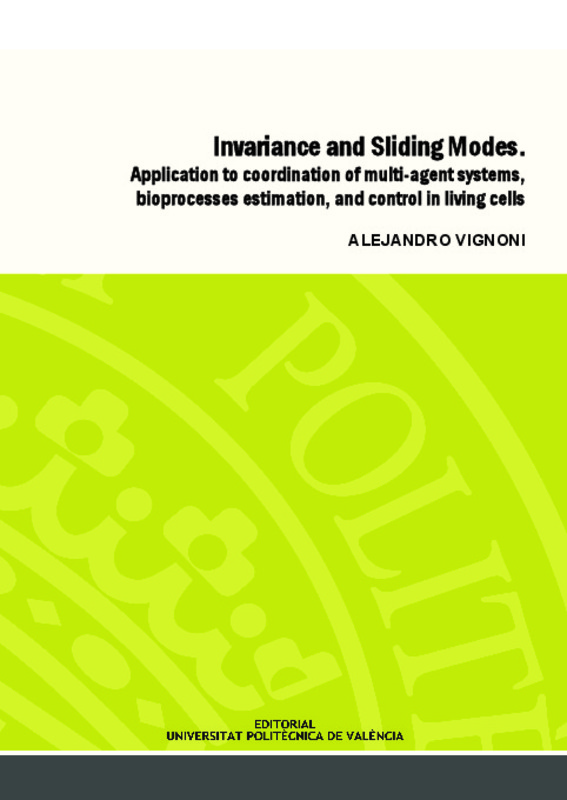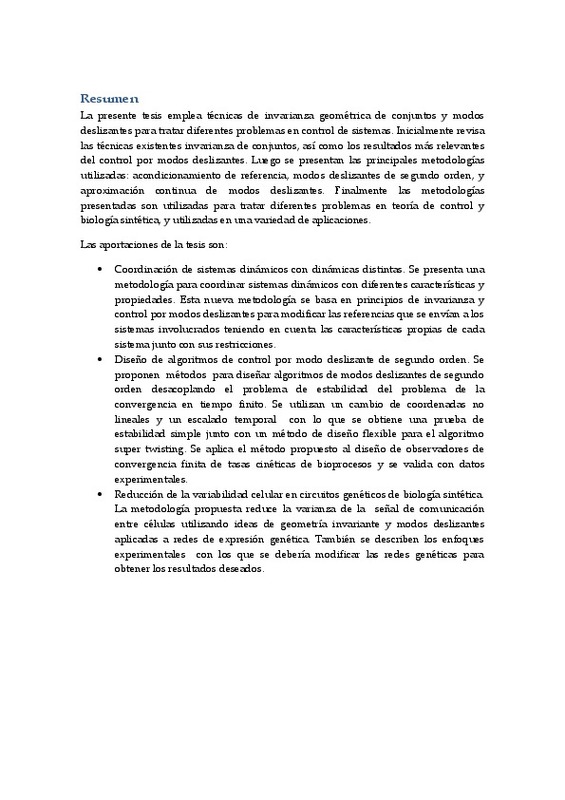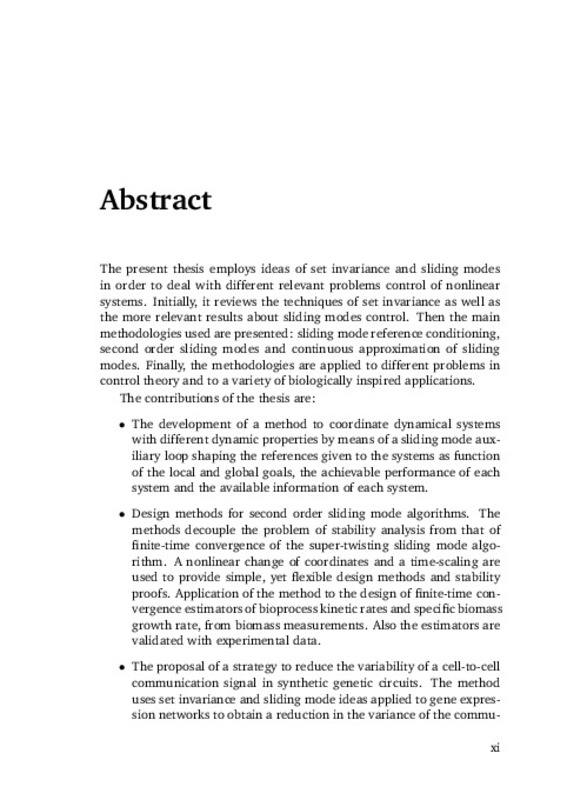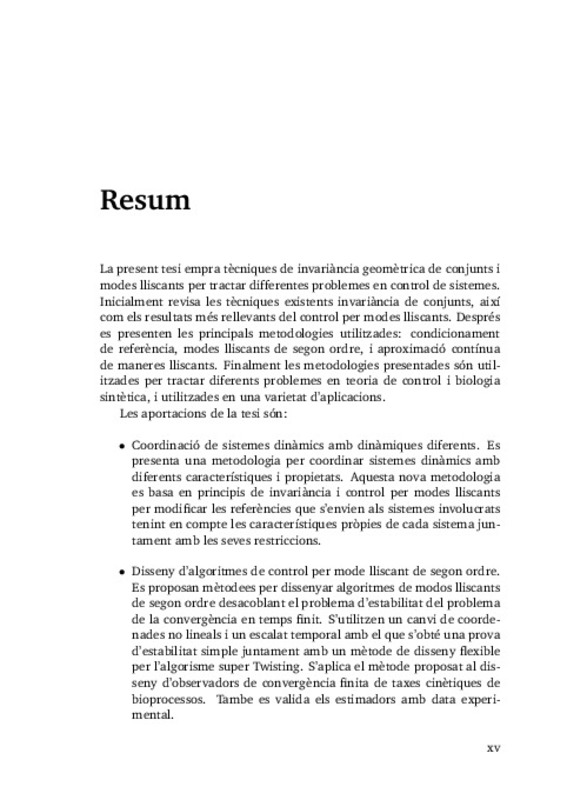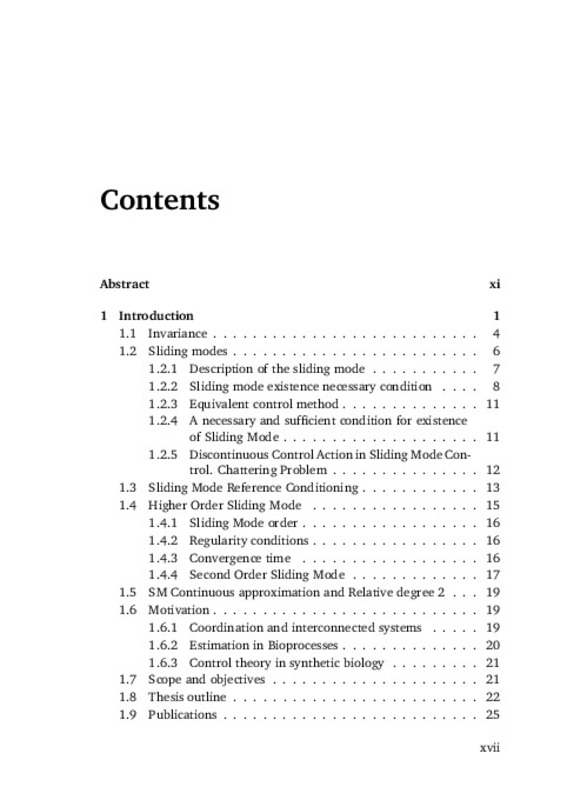- RiuNet repositorio UPV
- :
- Investigación
- :
- Tesis doctorales
- :
- Ver ítem
JavaScript is disabled for your browser. Some features of this site may not work without it.
Buscar en RiuNet
Listar
Mi cuenta
Estadísticas
Ayuda RiuNet
Admin. UPV
Invariance and Sliding Modes. Application to coordination of multi-agent systems, bioprocesses estimation, and control in living cells
Mostrar el registro sencillo del ítem
Ficheros en el ítem
| dc.contributor.advisor | Picó Marco, Jesús Andrés
|
es_ES |
| dc.contributor.author | Vignoni, Alejandro
|
es_ES |
| dc.date.accessioned | 2014-05-26T07:17:49Z | |
| dc.date.available | 2014-05-26T07:17:49Z | |
| dc.date.created | 2014-05-08T10:00:50Z | es_ES |
| dc.date.issued | 2014-05-26T07:17:46Z | es_ES |
| dc.identifier.isbn | 978-84-9048-256-8 | |
| dc.identifier.uri | http://hdl.handle.net/10251/37743 | |
| dc.description.abstract | The present thesis employs ideas of set invariance and sliding modes in order to deal with different relevant problems control of nonlinear systems. Initially, it reviews the techniques of set invariance as well as the more relevant results about sliding modes control. Then the main methodologies used are presented: sliding mode reference conditioning, second order sliding modes and continuous approximation of sliding modes. Finally, the methodologies are applied to different problems in control theory and to a variety of biologically inspired applications. The contributions of the thesis are: The development of a method to coordinate dynamical systems with different dynamic properties by means of a sliding mode auxiliary loop shaping the references given to the systems as function of the local and global goals, the achievable performance of each system and the available information of each system. Design methods for second order sliding mode algorithms. The methods decouple the problem of stability analysis from that of finite-time convergence of the super-twisting sliding mode algorithm. A nonlinear change of coordinates and a time-scaling are used to provide simple, yet flexible design methods and stability proofs. Application of the method to the design of finite-time convergence estimators of bioprocess kinetic rates and specific biomass growth rate, from biomass measurements. Also the estimators are validated with experimental data. The proposal of a strategy to reduce the variability of a cell-to-cell communication signal in synthetic genetic circuits. The method uses set invariance and sliding mode ideas applied to gene expression networks to obtain a reduction in the variance of the communication signal. Experimental approaches available to modify the characteristics of the gene regulation function are described. | en_EN |
| dc.language | Inglés | es_ES |
| dc.publisher | Editorial Universitat Politècnica de València | |
| dc.rights | Reserva de todos los derechos | es_ES |
| dc.source | Riunet | es_ES |
| dc.subject | Invariance | es_ES |
| dc.subject | Sliding modes | es_ES |
| dc.subject | Systems coordination | es_ES |
| dc.subject | Formation control | es_ES |
| dc.subject | Observers | es_ES |
| dc.subject | Estimators | es_ES |
| dc.subject | Bioprocess estimation | es_ES |
| dc.subject | Specific growth rate estimation | es_ES |
| dc.subject | Second order sliding mode observer | es_ES |
| dc.subject | Synthetic biology | es_ES |
| dc.subject | Genetic synthetic circuit | es_ES |
| dc.subject | Gene expression | es_ES |
| dc.subject | Protein variability control. | es_ES |
| dc.subject.classification | INGENIERIA DE SISTEMAS Y AUTOMATICA | es_ES |
| dc.title | Invariance and Sliding Modes. Application to coordination of multi-agent systems, bioprocesses estimation, and control in living cells | |
| dc.type | Tesis doctoral | es_ES |
| dc.identifier.doi | 10.4995/Thesis/10251/37743 | es_ES |
| dc.rights.accessRights | Abierto | es_ES |
| dc.contributor.affiliation | Universitat Politècnica de València. Departamento de Ingeniería de Sistemas y Automática - Departament d'Enginyeria de Sistemes i Automàtica | es_ES |
| dc.description.bibliographicCitation | Vignoni, A. (2014). Invariance and Sliding Modes. Application to coordination of multi-agent systems, bioprocesses estimation, and control in living cells [Tesis doctoral]. Editorial Universitat Politècnica de València. https://doi.org/10.4995/Thesis/10251/37743 | es_ES |
| dc.description.accrualMethod | TESIS | es_ES |
| dc.type.version | info:eu-repo/semantics/publishedVersion | es_ES |
| dc.relation.tesis | 8018 | es_ES |
Este ítem aparece en la(s) siguiente(s) colección(ones)
-
Tesis doctorales [5389]
-
Tesis. Editorial UPV [172]






